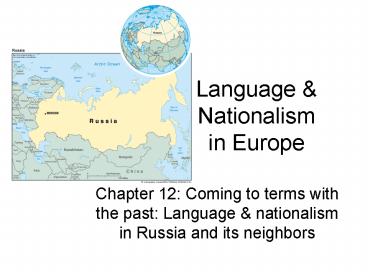Language - PowerPoint PPT Presentation
1 / 17
Title:
Language
Description:
All of the states discussed in this chapter were provinces of the ... Slavonic, with South Slavic features, functioned as the literary language until 18th c ... – PowerPoint PPT presentation
Number of Views:29
Avg rating:3.0/5.0
Title: Language
1
Language Nationalism in Europe
- Chapter 12 Coming to terms with the past
Language nationalism in Russia and its neighbors
2
Overview
- Discussion limited to
- Ukraine, Belarus, Russian Federation (European
part only) East Slavs - Moldova (ties to Romania)
- Estonia (ties to Finland)
- Latvia, Lithuania (historically tied to Poland
parts of Ukraine) Balts
3
Russian influence in the region
- Russia, as a major Orthodox power since 15th c,
has influenced Greeks, Bulgarians, Serbs, and
Romanians - All of the states discussed in this chapter were
provinces of the Romanov empire until 1917, and
then parts of the former Soviet Union - Large numbers of Russians settled in all of these
states, esp. since WWII
4
Jews and Germans in the region
- All states in the region have small minorities of
Jews - 1648-1654 100K Jews massacred in Ukraine
- Persecution of Jews (pogroms) continued up
through WWII - Huge numbers of Jews emigrated
- Germans invited to settle in Russian empire under
Catherine the Great, persecuted in WWII, many
emigrated in 1980s
5
The East Slavs
- 989 Kievan Rus and conversion to Christianity
- 1240 State collapsed, center of literacy moved to
Novgorod, then capital moved to Moscow under Ivan
the Terrible - Rulers became protectors of Orthodoxy after fall
of Constantinople in 1453
6
The East Slavs, contd.
- Old Church Slavonic, with South Slavic features,
functioned as the literary language until 18th c - Alphabetic divide between Orthodoxy with OCS and
Cyrillic alphabet vs. Latin church alphabet
7
Expansion of Russian Empire
- 17th-19th c Romanovs expand to East, incorporate
Siberia - 18th c Southward expansion to Black Sea
- 1703 Founding of St. Petersburg by Peter the
Great (multinational center) - 1721 Russian conquest of Baltic region
(previously in German hands) - 1762-95 Acquisition of Ukraine, Belarus, part of
Poland - 1861 Emancipation of serfs
8
Russification policies
- From Catherine the Great through the Romanovs,
all Russian rulers enforced Russification
(Russian in schools, administration, etc.) in all
acquired territories - Russian becomes lingua franca of the area
9
Russification policies, contd.
- Soviet Period Originally there was some
commitment to self-determination for the various
nationalities, but then Stalin reintroduced the
idea that language was one of the constitutive
elements of nationhood - Russian chauvinism prevailed and most languages
suffered serious decline in Soviet period - 1991 Disintegration of Soviet Union
10
Post-Soviet states their languages
- Belarus, Ukraine, Russia are all E Slavic, use
Cyrillic and show OCS influence - 1755 Lomonosov codified modern Russian
- 19th c Ukrainian codified
- 1906-14 Belarusian codified
- Some ideologues (Solzhenistyn, Rutskoi) have
suggested unification of the three E Slavic
countries
11
Post-Soviet states their languages, contd.
- Russian Federation is extremely linguistically
diverse - Ukraine 73 Ukrainian, 22 Russian
- Belarus 78 Belarusian, 13 Russian, but Belarus
was intensively Russified and most Belarusians
are more comfortable with Russian than with
Belarusian
12
Post-Soviet states their languages, contd.
- Estonia, Latvia, Lithuania
- Estonian is close to Finnish, most are Lutheran
- Lithuanian Latvian are close to each other, but
Lithuania is Catholic, Latvia is Protestant
13
Post-Soviet states their languages, contd.
- Estonia 64 Estonian, 30 Russian fluency in
Estonian required for citizenship - Latvia 54 Latvian, 33 Russian the number of
Russians who can apply for citizenship is limited
numerically every year - Lithuania 81 Lithuanian less strict citizenship
policies
14
Post-Soviet states their languages, contd.
- Moldova
- Romance language related to Romanian
- Turkish Yiddish minorities
15
Post-Soviet states their languages, contd.
- 1859 Romania discarded Cyrillic switched to
Latin, but Moldova kept Cyrillic - Soviet Union encouraged distinction between
Moldovan Romanian - 65 Moldovan, 13 Russian, 14 Ukrainian, 4
Gagauz (Turkish), 2 Bulgarian - 1988-9 switch to Latin alphabet recognition of
identity with Romanian
16
Post-Soviet states their languages, contd.
- Ukraine -- particularly complex, many dialects
are very close to Russian, many people are
bilingual, close ties also to Polish - Ukraine was breadbasket of Russia/Soviet Union
- Ukrainian often identified as Little Russian or
South Russian - Multiple loyalties are the norm, Ukrainian
nationalism is a minority faith
17
Concluding notes
- Economies have declined in post-Soviet era,
creating potential for trouble that could be
exploited by nationalists. With some terrible
exceptions (Chechnya), much violence has been
avoided































